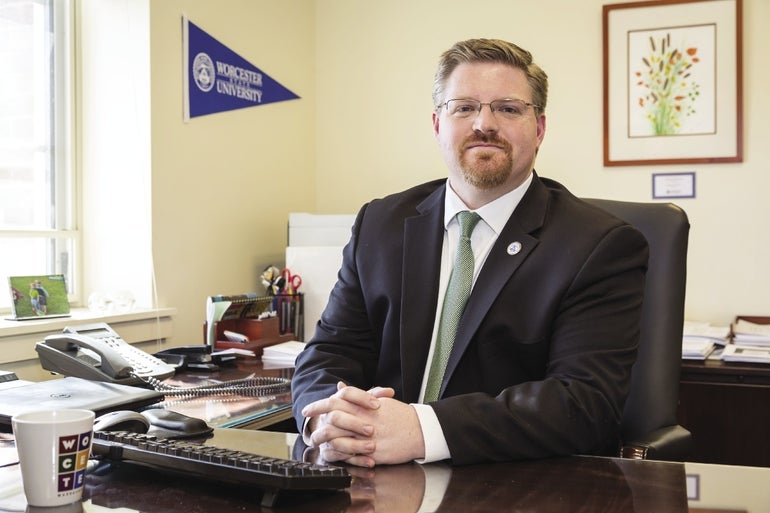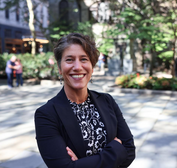Central Mass. colleges showcase affordability
 PHOTO/Matt VOLPINI
Ryan Forsythe, vice president of enrollment management, Worcester State University
PHOTO/Matt VOLPINI
Ryan Forsythe, vice president of enrollment management, Worcester State University
As Central Massachusetts colleges and universities compete for a shrinking student population, affordability is becoming a key marketing tool, as tuition freezes and cost-controlled partnerships are quickly become new ways to entice cost-conscious applicants.
“We know the competition for students has never been more acute, especially in the Northeast. We also know that students and families have many great options for higher education. As a result, we are constantly working at sharpening our value proposition,” said William Boffi, vice president of enrollment at Nichols College in Dudley, which has frozen tuition for the fall semester.
While applications have risen for colleges, enrollment has declined. Of the four-year colleges surveyed in May by the National Association for College Admission Counseling, 70 percent reported application increases in 10 of the 15 years leading up to 2013. However, only 36 percent of those applicants enrolled in 2013, down from 49 percent in 2002.
To market affordable degrees, Massachusetts community colleges – including Quinsigamond Community College in Worcester and Mount Wachusett Community College in Gardner – have partnered with public and private higher education institutions to offer four-year degrees at a fixed cost to full-time, non-residential students. Other schools – like Nichols, Assumption College and all state universities – froze tuition to show a committment to affordable education.
QCC and MWCC have partnered with Worcester State and Fitchburg State universities to offer a $30K Commitment, where students can earn an associate's degree at either community college and then transfer to one of the two four-year schools to complete their bachelor's degree.
“This program is nothing super revolutionary. Students could have gone to Quinsig and come to Worcester State. They could have done it all for less than $30,000. But by doing this, sort of packaging it this way, we think we're making students more aware of the opportunity that already existed, and we're very very clearly delineating what that path is,” said Ryan Forsythe, WSU vice president of enrollment management. “We're helping them realize it's a path that they can take.”
Capping costs
What is revolutionary, Forsythe said, is that students who enter the $30K Commitment won't be susceptible to hikes in tuition or fees. Plus, the program doesn't take into account financial aid, so many students could end up paying a lot less. At Worcester State, about 65 percent of students receive financial aid, Forsythe said.
“Capping students' cost is a major component of the $30K Commitment, as it will shelter students with locked-in prices regardless of any proposed changes in tuition or fees during their studies,” said Matthew J. Bruun, FSU director of public affairs. “The program also highlights institutional commitment to student success, as it aligns high-demand courses of study at the community college and university levels.”
The increased scrutiny on the higher education system in the U.S. came about because federal regulators in Congress, the White House and the U.S. Department of Justice have all started to focus in on the relationship between undergraduate success, gainful employment, and net student and family debt burden, said James E. Samels, president and CEO of the Framingham higher education consulting firm the Education Alliance.
“Higher education is to 2016 what health care was to 2015,” he said. “There is a rising expectation in the public that higher education, if not free, should be subsidized to make it an affordable attainment.”
As of March 2015, total student loan debt nationwide was $1.27 trillion, whereas in 2006, it was just under $500 million, according to the Board of Governors of the Federal Reserve System.
Tuition freezes
Tuition has been frozen at state schools and community colleges for years, but that is really not an indicator of commitment to affordability, as the schools hike their significant fees every year. When it comes to paying for education at a state school or community college in Massachusetts, fees far outweigh tuition in terms of price. For example, at Mount Wachusett, tuition for fiscal year 2016 was $750, but fees were $5,350.
The Massachusetts Board of Higher Education sets tuition and fees for public schools and community colleges, and fees are determined based on the amount of money appropriated to each college from the state. Fees went up 5 percent at Framingham State University between fiscal year 2015 and 2016, by 8 percent at Fitchburg State and 4 percent at Worcester State. They went up 3 percent at Mount Wachusett and 5 percent at QCC, according to Massachusetts Department of Higher Education.
At private schools, however, tuition usually far outweighs any other cost. At Nichols, tuition makes up about 70 percent of the total cost of college for students who live on campus and about 99 percent for non-residents, said Boffi. The board of directors voted in January of last year to freeze tuition for the second time in four years because it wanted to show it is committed to affordability.
Assumption College froze its tuition in February 2014 and has since extended those savings to everyone through the class of 2020, in order to show its commitment to providing affordable college to potential students.
The average tuition and fees for a nonresident in-state public university student for the 2015-2016 year came out to $9,410, according to the College Board, which tracks college costs and adjusts the numbers for inflation. In 2010, the same student paid $8,351, and the cost went up slightly each year.
At a private nonprofit four-year school, tuition and fees for a non-residential student rounded out to $32,405 for 2015-2016, up from $29,300 in 2010.
The community college route
The College Board found about 61 percent of students who earned bachelor's degrees in the 2013-2014 school year at the same four-year college where they began their studies graduated with an average debt of $26,900, a 17-percent inflation adjusted increase over a decade.
“A growing number of students are realizing the cost benefits of beginning their undergraduate degrees at a community college, before transferring to continue on for bachelor's degrees, master's degrees, and beyond,” said Lea Ann Scales, vice president of external affairs and communications at Mount Wachusett.
QCC has partnered with Anna Maria College in Paxton, offering degrees in fire science/emergency management, criminal justice, social work or human services for $40,000 or less, depending on a student's financial aid package. The cost of attending Anna Maria for the 2015-2016 school year, including tuition and fees but excluding room and board, is about $35,074, so the cost savings are significant, said Anna Maria President Mary Lou Retelle..
So far, about 10 Quinsigamond students have expressed serious interest in signing on to the program, Retelle said. About 10 percent of Anna Maria graduates transfer in from community colleges, and Retelle expects that number will increase because of the partnership.
“With the whole debate in higher education about affordability, I would imagine more and more students are looking for affordable options for a degree,” she said.













0 Comments